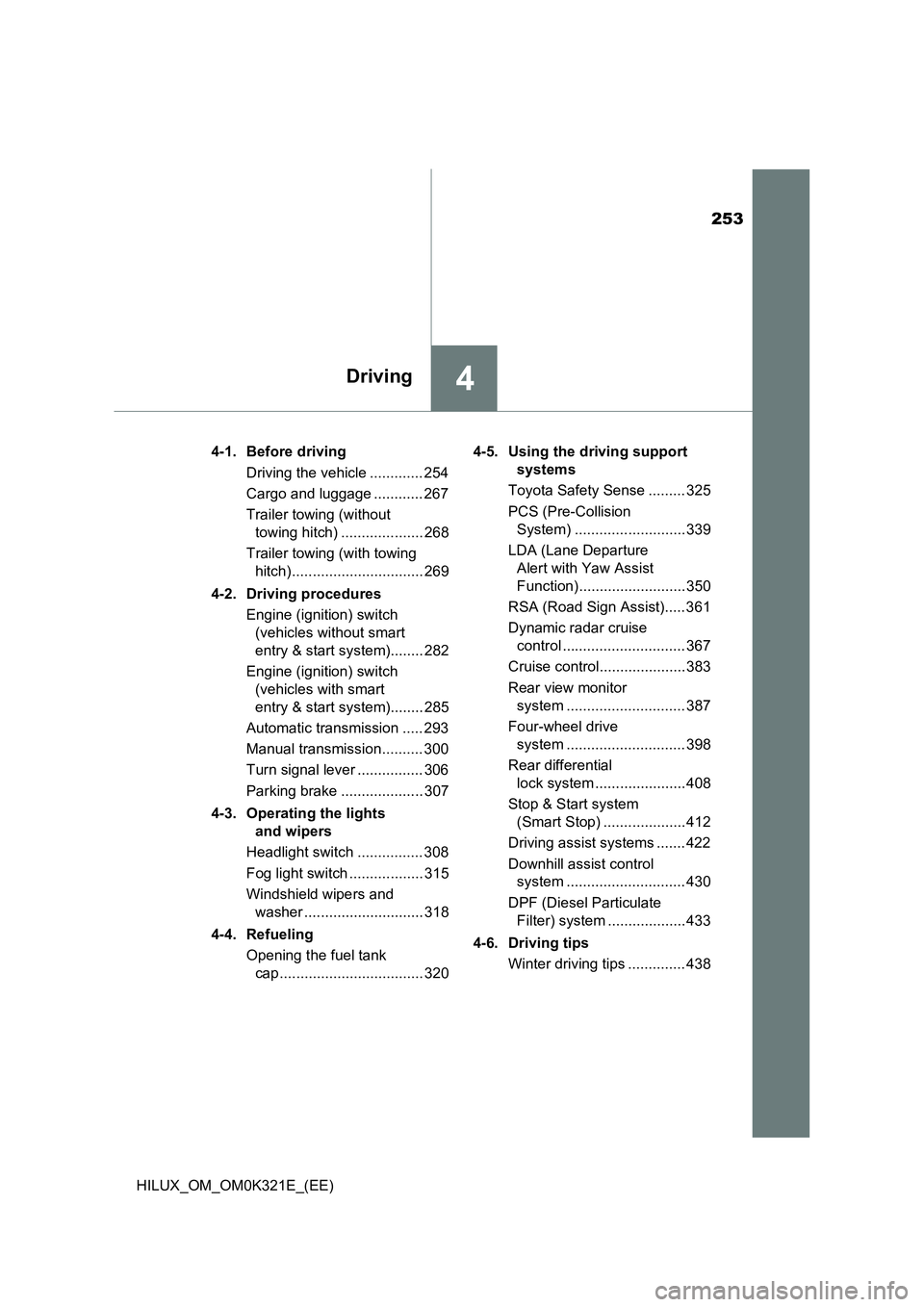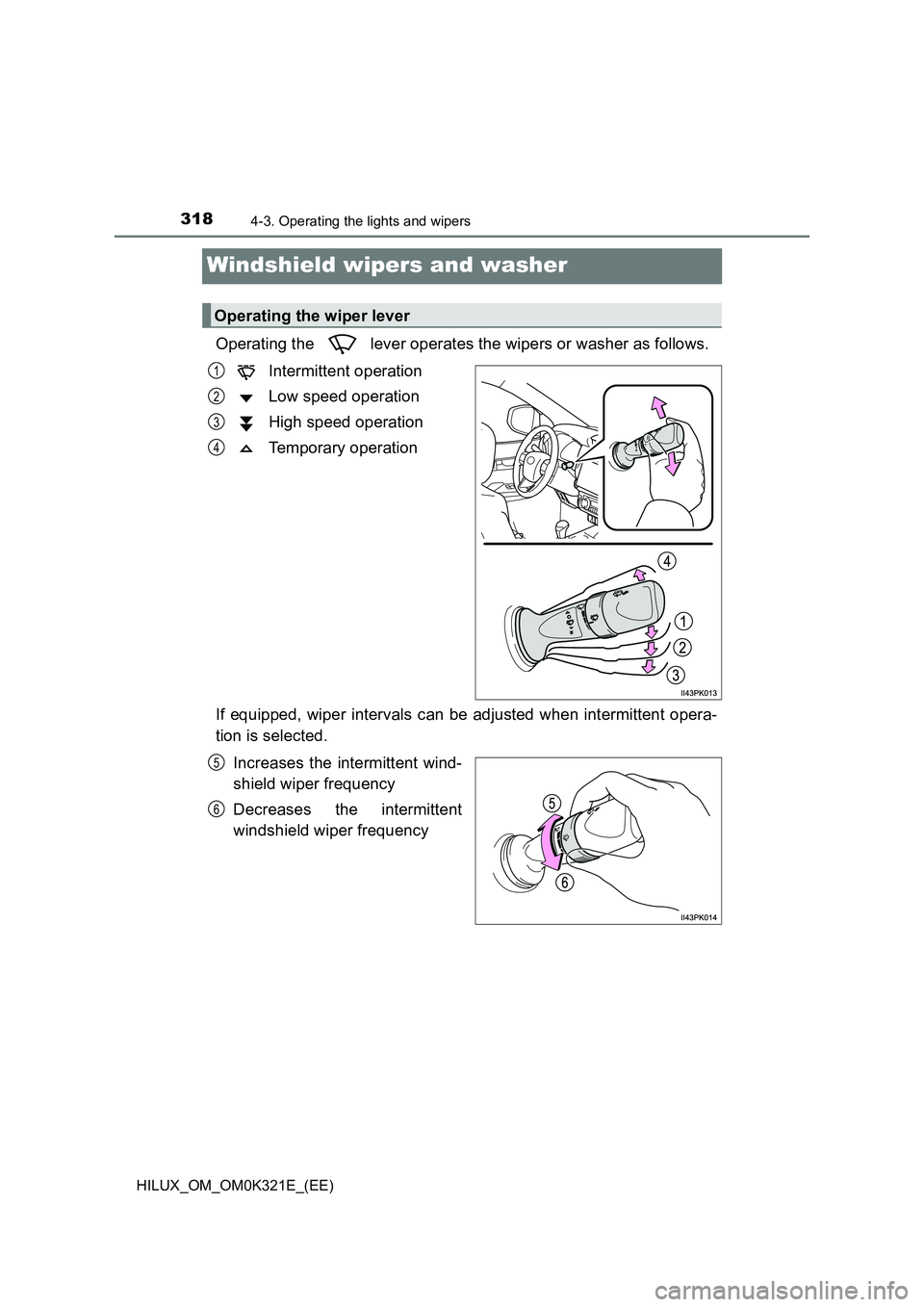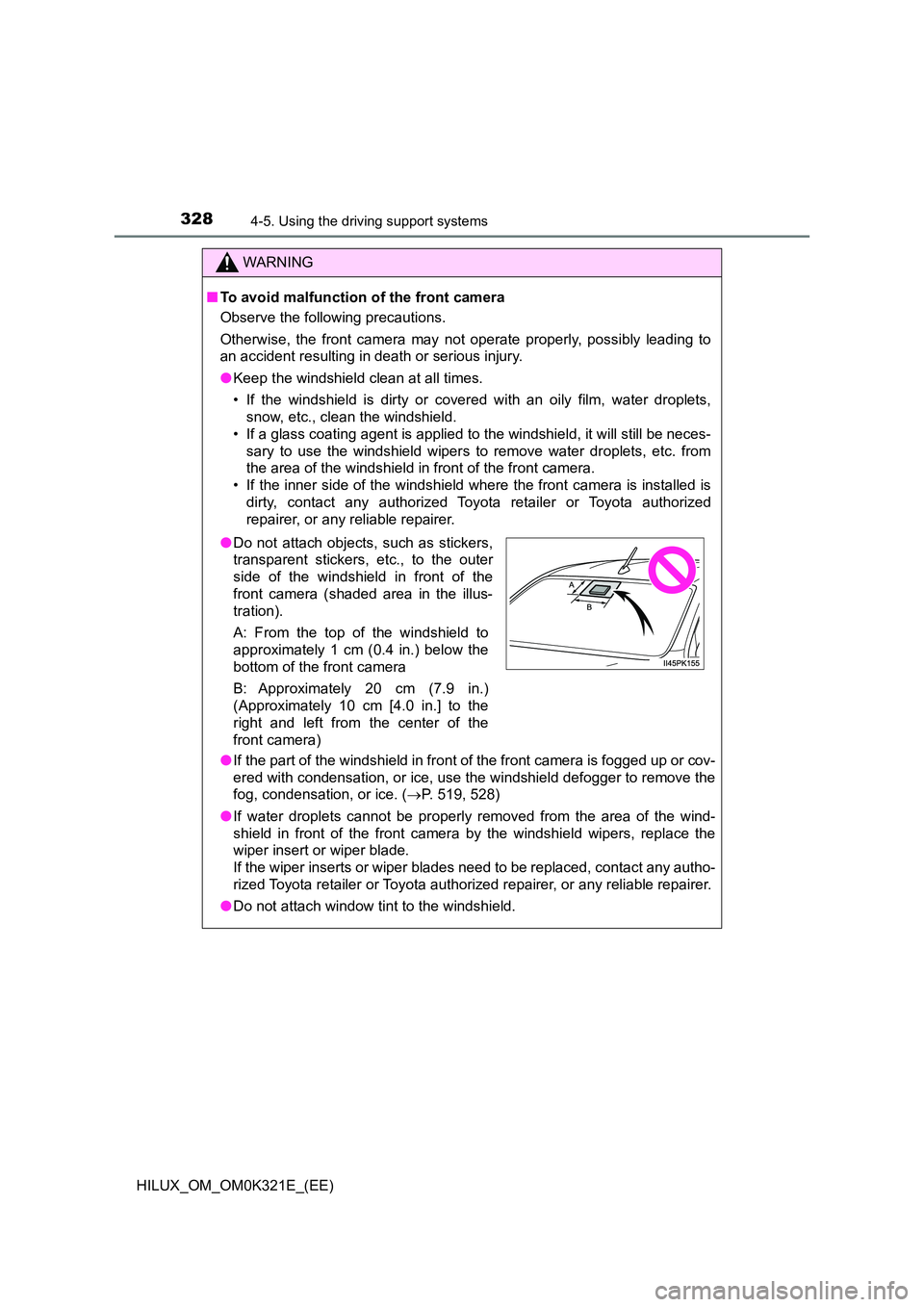2020 TOYOTA HILUX windshield wipers
[x] Cancel search: windshield wipersPage 3 of 744

3
1
9
8
6
5
4
3
2
HILUX_OM_OM0K321E_(EE)
7
3-5. Opening and closing
the windows
Power windows ..................248
Quarter windows
(smart-cab models)..........252
4-1. Before driving
Driving the vehicle .............254
Cargo and luggage ............267
Trailer towing (without
towing hitch) ....................268
Trailer towing (with towing
hitch) ................................269
4-2. Driving procedures
Engine (ignition) switch
(vehicles without smart
entry & start system)........282
Engine (ignition) switch
(vehicles with smart
entry & start system)........285
Automatic transmission......293
Manual transmission ..........300
Turn signal lever ................306
Parking brake.....................307
4-3. Operating the lights
and wipers
Headlight switch.................308
Fog light switch ..................315
Windshield wipers and
washer .............................318
4-4. Refueling
Opening the fuel tank
cap .................................. 320
4-5. Using the driving support
systems
Toyota Safety Sense ......... 325
PCS (Pre-Collision
System) ........................... 339
LDA (Lane Departure
Alert with Yaw Assist
Function) ......................... 350
RSA (Road Sign Assist) .... 361
Dynamic radar cruise
control ............................. 367
Cruise control .................... 383
Rear view monitor
system............................. 387
Four-wheel drive
system............................. 398
Rear differential
lock system ..................... 408
Stop & Start system
(Smart Stop).................... 412
Driving assist systems....... 422
Downhill assist control
system............................. 430
DPF (Diesel Particulate
Filter) system .................. 433
4-6. Driving tips
Winter driving tips.............. 438
5-1. Basic Operations
Audio system types ........... 442
Steering wheel audio
switches .......................... 444
AUX port/USB port ............ 447
4Driving
5Audio system
Page 19 of 744

19Pictorial index
HILUX_OM_OM0K321E_(EE)
Windshield wipers . . . . . . . . . . . . . . . . . . . . . . . . . . . . . . . . . P. 318
Precautions against winter season . . . . . . . . . . . . . . . . . . . . . P. 438
To prevent freezing (windshield wiper de-icer)*1. . . . . . . . . . . P. 520
Fuel filler door*1 . . . . . . . . . . . . . . . . . . . . . . . . . . . . . . . . . . P. 320
Refueling method . . . . . . . . . . . . . . . . . . . . . . . . . . . . . . . . . . P. 320
Fuel type/fuel tank capacity . . . . . . . . . . . . . . . . . . . . . . . . . . . P. 695
Tires . . . . . . . . . . . . . . . . . . . . . . . . . . . . . . . . . . . . . . . . . . . . P. 590
Tire size/inflation pressure . . . . . . . . . . . . . . . . . . . . . . . . . . . . P. 711
Winter tires/tire chain . . . . . . . . . . . . . . . . . . . . . . . . . . . . . . . . P. 438
Checking/rotation. . . . . . . . . . . . . . . . . . . . . . . . . . . . . . . . . . . P. 591
Coping with flat tires . . . . . . . . . . . . . . . . . . . . . . . . . . . . . . . . P. 649
Hood . . . . . . . . . . . . . . . . . . . . . . . . . . . . . . . . . . . . . . . . . . . . P. 568
Opening . . . . . . . . . . . . . . . . . . . . . . . . . . . . . . . . . . . . . . . . . . P. 568
Engine oil . . . . . . . . . . . . . . . . . . . . . . . . . . . . . . . . . . . . . . . . . P. 696
Coping with overheat . . . . . . . . . . . . . . . . . . . . . . . . . . . . . . . . P. 678
Camera*1 . . . . . . . . . . . . . . . . . . . . . . . . . . . . . . . . . . . . . . . . P. 387
Headlights . . . . . . . . . . . . . . . . . . . . . . . . . . . . . . . . . . . . . . . P. 308
Front position lights/daytime running lights*1. . . . . . . . . . P. 308
Front fog lights*1/rear fog light*1, 2. . . . . . . . . . . . . . . . . . . P. 315
Front turn signal lights . . . . . . . . . . . . . . . . . . . . . . . . . . . . . P. 306
Side turn signal lights (fender-mounted type or
mirror-mounted type) . . . . . . . . . . . . . . . . . . . . . . . . . . . . . . P. 306
Rear turn signal lights. . . . . . . . . . . . . . . . . . . . . . . . . . . . . . P. 306
Stop/tail lights . . . . . . . . . . . . . . . . . . . . . . . . . . . . . . . . . . . . P. 308
Downhill assist control system*1. . . . . . . . . . . . . . . . . . . . . . . P. 430
License plate light . . . . . . . . . . . . . . . . . . . . . . . . . . . . . . . . . P. 308
Back-up lights*2
Shifting the shift lever to R. . . . . . . . . . . . . . . . . . . . . . . . P. 293, 300
4
5
6
7
8
Light bulbs of the exterior lights for driving
(Replacing method: P. 607, Watts: P. 714)
*1: If equipped
*2: They may be located on the opposite side depending on the target region.
9
10
11
12
13
14
15
16
17
Page 253 of 744

253
4Driving
HILUX_OM_OM0K321E_(EE)
4-1. Before driving
Driving the vehicle ............. 254
Cargo and luggage ............ 267
Trailer towing (without
towing hitch) .................... 268
Trailer towing (with towing
hitch)................................ 269
4-2. Driving procedures
Engine (ignition) switch
(vehicles without smart
entry & start system)........ 282
Engine (ignition) switch
(vehicles with smart
entry & start system)........ 285
Automatic transmission ..... 293
Manual transmission.......... 300
Turn signal lever ................ 306
Parking brake .................... 307
4-3. Operating the lights
and wipers
Headlight switch ................ 308
Fog light switch .................. 315
Windshield wipers and
washer ............................. 318
4-4. Refueling
Opening the fuel tank
cap ................................... 320
4-5. Using the driving support
systems
Toyota Safety Sense ......... 325
PCS (Pre-Collision
System) ........................... 339
LDA (Lane Departure
Alert with Yaw Assist
Function).......................... 350
RSA (Road Sign Assist)..... 361
Dynamic radar cruise
control .............................. 367
Cruise control..................... 383
Rear view monitor
system ............................. 387
Four-wheel drive
system ............................. 398
Rear differential
lock system ...................... 408
Stop & Start system
(Smart Stop) .................... 412
Driving assist systems ....... 422
Downhill assist control
system ............................. 430
DPF (Diesel Particulate
Filter) system ................... 433
4-6. Driving tips
Winter driving tips .............. 438
Page 312 of 744

3124-3. Operating the lights and wipers
HILUX_OM_OM0K321E_(EE)
This system allows the headlights and front position lights to be turned
on for 30 seconds when the engine switch is turned to the “LOCK”
position (vehicles without smart entry & start system) or off (vehicles
with smart entry & start system).
Pull the lever toward you and
release it with the light switch is in
or after turning the
engine switch to the “LOCK” posi-
tion (vehicles without smart entry
& start system) or off (vehicles
with smart entry & start system).
Pull the lever toward you and
release it again to turn off the
lights.
■ Daytime running light system (if equipped)
To make your vehicle more visible to other drivers during daytime driving, the
daytime running lights turn on automatically whenever the engine is started
with the headlight switch in or . (Illuminate brighter than the front
position lights.) The daytime running light system is not designed for use at
night.
■ Headlight control sensor (if equipped)
Follow me home system (if equipped)
The sensor may not function properly if an
object is placed on the sensor, or anything
that blocks the sensor is affixed to the
windshield.
Doing so interferes with the sensor
detecting the level of ambient light and
may cause the automatic headlight sys-
tem to malfunction.
Page 318 of 744

3184-3. Operating the lights and wipers
HILUX_OM_OM0K321E_(EE)
Windshield wipers and washer
Operating the lever operates the wipers or washer as follows.
Intermittent operation
Low speed operation
High speed operation
Temporary operation
If equipped, wiper intervals can be adjusted when intermittent opera-
tion is selected.
Increases the intermittent wind-
shield wiper frequency
Decreases the intermittent
windshield wiper frequency
Operating the wiper lever
1
2
3
4
5
6
Page 319 of 744

3194-3. Operating the lights and wipers
4
Driving
HILUX_OM_OM0K321E_(EE)
Washer/wiper dual
operation
Pulling the lever operates the
wipers and washer.
The wipers will automatically
operate a couple of times after
the washer squirts.
If the headlights are on, the
headlight cleaners will operate
once.
And then, the headlight cleaners
will operate every five times you
pull the lever. (if equipped)
■ The windshield wipers and washer can be operated when
The engine switch is in the “ON” position (vehicles without smart entry & start
system) or IGNITION ON mode (vehicles with smart entry & start system).
■ If no windshield washer fluid sprays
Check that the washer nozzles are not blocked if there is washer fluid in the
windshield washer fluid reservoir.
7
WARNING
■ Caution regarding the use of washer fluid
When it is cold, do not use the washer fluid until the windshield becomes
warm. The fluid may freeze on the windshield and cause low visibility. This
may lead to an accident, resulting in death or serious injury.
NOTICE
■ When the windshield is dry
Do not use the wipers, as they may damage the windshield.
■ When the washer fluid tank is empty
Do not operate the switch continually as the washer fluid pump may over-
heat.
■ When a nozzle becomes blocked
In this case, contact any authorized Toyota retailer or Toyota authorized
repairer, or any reliable repairer.
Do not try to clear it with a pin or other object. The nozzle will be damaged.
Page 328 of 744

3284-5. Using the driving support systems
HILUX_OM_OM0K321E_(EE)
WARNING
■To avoid malfunction of the front camera
Observe the following precautions.
Otherwise, the front camera may not operate properly, possibly leading to
an accident resulting in death or serious injury.
● Keep the windshield clean at all times.
• If the windshield is dirty or cover ed with an oily film, water droplets,
snow, etc., clean the windshield.
• If a glass coating agent is applied to t he windshield, it will still be neces-
sary to use the windshield wipers to remove water droplets, etc. from
the area of the windshield in front of the front camera.
• If the inner side of the windshield where the front camera is installed is
dirty, contact any authorized Toyota retailer or Toyota authorized
repairer, or any reliable repairer.
● If the part of the windshield in front of the front camera is fogged up or cov-
ered with condensation, or ice, use the windshield defogger to remove the
fog, condensation, or ice. ( P. 519, 528)
● If water droplets cannot be properly removed from the area of the wind-
shield in front of the front camera by the windshield wipers, replace the
wiper insert or wiper blade.
If the wiper inserts or wiper blades need to be replaced, contact any autho-
rized Toyota retailer or Toyota authorized repairer, or any reliable repairer.
● Do not attach window tint to the windshield.
●Do not attach objects, such as stickers,
transparent stickers, etc., to the outer
side of the windshield in front of the
front camera (shaded area in the illus-
tration).
A: From the top of the windshield to
approximately 1 cm (0.4 in.) below the
bottom of the front camera
B: Approximately 20 cm (7.9 in.)
(Approximately 10 cm [4.0 in.] to the
right and left from the center of the
front camera)
Page 337 of 744

3374-5. Using the driving support systems
4
Driving
HILUX_OM_OM0K321E_(EE)
■ If a warning message is displayed on the multi-information display
A system may be temporarily unavailable or there may be a malfunction in
the system.
● In the following situations, perform the actions specified in the table. When
the normal operating conditions are detected, the message will disappear
and the system will become operational.
If the message does not disappear, contact any authorized Toyota retailer
or Toyota authorized repairer, or any reliable repairer.
SituationActions
When the area around a sensor
is covered with dirt, moisture
(fogged up, covered with con-
densation, ice, etc.), or other
foreign matter
To clean the part of the windshield in front
of the front camera, use the windshield
wipers or the windshield defogger of the
air conditioning system ( P. 519, 528).
When the temperature around
the front camera is outside of
the operational range, such as
when the vehicle is in the sun or
in an extremely cold environ-
ment
If the front camera is hot, such as after
the vehicle had been parked in the sun,
use the air conditioning system to
decrease the temperature around the
front camera.
If a sunshade was used when the vehi-
cle was parked, depending on its type,
the sunlight reflected from the surface
of the sunshade may cause the tem-
perature of the front camera to become
excessively high.
If the front camera is cold, such after the
vehicle is parked in an extremely cold
environment, use the air conditioning
system to increase the temperature
around the front camera.
The area in front of the front
camera is obstructed, such as
when the hood is open or a
sticker is attached to the part of
the windshield in front of the
front camera.
Close the hood, remove the sticker, etc.
to clear the obstruction.